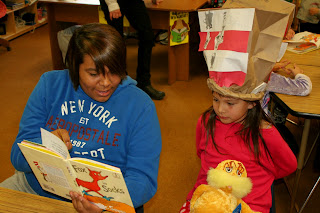 During a recent lunch period, the high school student commons was bustling as usual. Students were sitting in groups, milling around, listening to music, and working on schoolwork. All of a sudden, a handful of students stood in the front of the room and called for everyone’s attention. Their schoolmates were about to be introduced to street theater.
During a recent lunch period, the high school student commons was bustling as usual. Students were sitting in groups, milling around, listening to music, and working on schoolwork. All of a sudden, a handful of students stood in the front of the room and called for everyone’s attention. Their schoolmates were about to be introduced to street theater. The one-act play that followed was created by the Introduction to Theater class, taught by Molly Humphrey. The exercise was the culmination of a unit in which the class looked at how theater is used to effect change in society. Before having the students come up with a topic, Humphrey showed them video clips of street theater, and told them to keep what they saw in mind as they created their own dramatic piece.
The students were asked to think of a subject that was close to home; an issue that affects their lives and their community. The topic that the students settled on was that of the town of Whiteclay, Nebraska. The Pine Ridge Reservation is officially “dry”, meaning that alcohol may not be legally bought, sold, or consumed anywhere on the 3,000-square mile territory. Whiteclay is a tiny town lying two miles south of the town of Pine Ridge, just across the state line in Nebraska, and therefore off the official boundary of the reservation. Its primary reason for existence is to sell alcohol, and the liquor stores that line the town’s main street sell an average of 4 million cans of beer annually.
The play that the students conceived revolved around six main characters; two Pine Ridge teens who speed off to Whiteclay for a night of drinking and partying, two derelicts living homeless in Whiteclay itself, and two tribal police officers. The students worked together to come up with the play’s outline. Then each student who was assigned to play a part wrote his or her lines individually, and they were compiled into the plot and edited for smooth flow. The process took about two weeks from start to finish, including time for the performers to get their lines and blocking down. As for the venue, it was a student who had the original idea to do the play in the student commons at lunch.
The most powerful part of the one-act play came at the closure. One-by-one, the students stepped out of their roles, and delivered strong affirmations of the personal strengths. Examples of these declarations included; “I spend my free time taking care of my horses and dancing in powwows.”, “I am preparing myself to go to college to get my business degree.”, and “I am the pride and joy of my family. I won three art awards at the Lakota Nation Invitational.”
Following their individual affirmations, the students joined together to proclaim the final line: “We are the next generation of the Lakota, and we are on a path to make our ancestors proud.”
Humphrey feels that the play was a success, and hopes that the students can create and perform another such piece before the end of the year. The students involved enjoyed themselves, while at the same time educating themselves about an important community issue. Sophomore Brannon Cousin stated, “We found out about a lot of the negative effects that alcohol has on the reservation, such as how many people are unemployed due to alcohol addiction, and the amount of babies that are born with FAS (Fetal Alcohol Syndrome).” This learning is a key component of much street theater, and also of the educational experience overall. By that measure, the theater class’ project was a resounding success.


